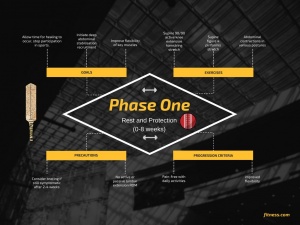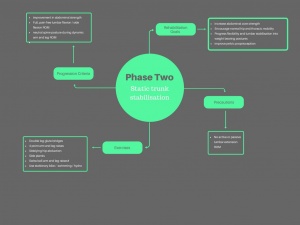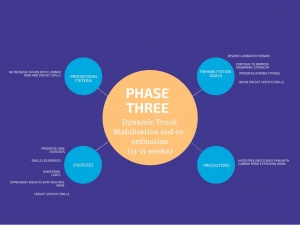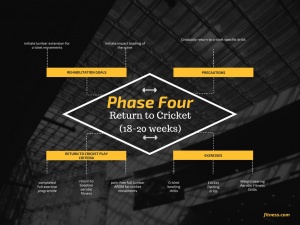Exercise Therapy in the Rehabilitation of Spondylolisthesis in Fast Bowlers in Cricket
Introduction[edit | edit source]
blah blah blah
Objectives[edit | edit source]
blah blah blah
Pathology and Classification[edit | edit source]
blah blah blah
Epidemiology[edit | edit source]
blah blah blah
Biomechanics of Bowling[edit | edit source]
blah blah blah
Indications for Surgery[edit | edit source]
blah blah blah
Exercise Therapy[edit | edit source]
Exercise Therapy is part of the conservative approach that is recommended for some athletes who have a spondylolisthesis. It is important as a physiotherapist to ensure that athletes have had medical clearance from a doctor before beginning a rehabilitation programme. Here we will discuss the Exercise Therapy programme that we have created based upon current literature/protocols that pre-exist (for athletes) for a cricketer (Uwhealth.org,2018; Nau, Hanney and Kolber, 2008).
Phase One - is titled ‘Rest and Protection’. The rehabilitation goals of this stage are:
- allow adequate time for healing to occur
- initiate abdominal and spinal stabilisers
- Improve flexibility of key muscles
For healing to occur, there needs to be a period of rest. This component where agrravating activities are stopped is consistent throughout literature. A comprehensive review discussed management of low-grade spondylolisthesis in athletes. They included 14 studies investigating conservative treatment. They argued that rest is essential for management. In soccer athletes, they found that athletes who underwent activity modification as treatment rather than rest had worse outcomes in terms of return to sport in terms of time loss, but also in pain and function (Bouras and Korovessis, 2015) . Iwamoto (2010) in his return to sport article also agreed that a period of rest should be included, and that the aim is to be pain free during daily routine activities before any sport-specific exercises or strengthening exercises occur. It is this rest period that enables athletes to return pain-free to competition. Expert John Orchard who is chief medical officer for Australia Cricket reported that it is crucial that we unload our athletes before we carry out rehabilitation. The controversial point in the literature is on the duration of rest, some saying 4-6 weeks and others arguing up to 3 months.
There is debate in literature with regard to bracing during this period of rest. Literature suggests that bracing is considered if the athlete is still symptomatic after 2-4 weeks. However in a recent meta-analysis, they have reported that bracing is ineffective on outcomes. The aim of rest is to reduce extension stress of the lumbar spine and to promote anti-lordotic posture, so some authors believe bracing can help (Klein, Mehlmann and McCarty, 2009).
Next goal was to start to include core stabilisation exercises. From experts opinion, athletes tend to focus on the larger muscle groups and neglect the muscles (transverse abdominis, paraspinals, internal and external obliques, rectus abdominus and multifidus) responsible for spinal stabilisation. Strengthening these muscles can provide support by lifting the spine and maintaining neutral pelvic alignment thus transferring the force and thereby decreasing the amount of load to the area. Furthermore, transverse abdominis and multifidus have local stabilisation able to prevent excessive movements at regions of instability or hypermobility. These two groups of muscles will co-contract to provide a balanced effect in the spine. Multifidus is a deep muscle which attaches directly into the vertebra, therefore it is crucially important we provide exercises to work this muscle (Nau, Hanney and Kolber, 2008). A systematic review on risk factors and successful interventions for cricket related LBP recommended stabilisation exercises to reduce pain and increase the anterior abdominal slide (Morton et al., 2013).
The final goal was to improve flexibility of the key muscles. Standaert and Herring (2007) explain the importance for a broader kinetic chain assessment (pelvic and hamstrings, glutes) . Flexibility is an important component of spinal conditioning programs. Sometimes athletes may present with a secondary finding of hamstring or paraspinal muscle tightness perhaps to offer some sort of stabilisation. Exercises to address flexibility of the hamstrings, rectus femoris and tensor sascia latae musculature have been recognised as an integral component of the spinal conditioning program in those with spondylolitic disorders. This tightness can increase the lumbar lordosis due to direct effects on pelvic alignment, increasing strain on already unstable vertebrae. Static stretching is advocated for a duration of 30 seconds for 3 repetitions, twice a day, daily. With all of the stretches we have prescribed or recommended we are looking for it to remain pain-free. If a stretch induces pain, relieve pressure until pain-free and start again (Nau, Hanney and Kolber, 2008).
During this phase, it is crucial that athletes avoid lumbar extension to avoid stressing the lumbar spine. The duration of the first stage varies amongst different athletes. It is important that there is adequate time left to rest and be pain-free to allow healing to occur before progression onto the second phase (Perrin, 2016).
Exercises include in this phase are:
- Dynamic Hamstring 90/90 stretch
- Supine figure four Piriformis stretch
- Transverse Abdominisicontractionsn prone, supine and standing posture
Phase Two - blah blah blah
Phase Three -
blah blah blah
Phase Four -
blah blah blah]
Download full Exercise Therapy Rehabilitation Programme
Suggested Exercises[edit | edit source]
[https://youtu.be/pgc5K_GkgTo - Please click here to see a video of suggested exercises based upon current literature for Cricketers with Spondylolisthesis.
Future Recommendations[edit | edit source]
blah blah blah
Clinical Bottom Line[edit | edit source]
blah blah blah










